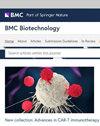多蛋白胶原/角蛋白水凝胶促进小鼠模型中受伤骨骼肌的肌生成和血管生成
IF 3.5
3区 生物学
Q2 BIOTECHNOLOGY & APPLIED MICROBIOLOGY
引用次数: 0
摘要
体积损失是肌肉组织结构造成功能障碍的难题之一。使用合适的水凝胶进行肌肉组织工程是恢复受伤部位生理特性的一种替代方法。本文研究了 I 型胶原蛋白(0.5%)和角蛋白(0.5%)在小鼠股二头肌损伤模型中的生肌特性。通过傅立叶变换红外光谱、凝胶时间和流变分析,分析了胶原蛋白(Col)/角蛋白支架的理化性质。小鼠 C2C12 成肌细胞负载的 Col/Keratin 水凝胶被注射到损伤部位,15 天后进行组织学检查和 Western 印迹分析,以测量成肌潜能。傅立叶变换红外光谱(FTIR)显示角蛋白与胶原蛋白之间存在适当的相互作用。与单用胶原蛋白组相比,胶原蛋白/角蛋白混合组延迟了凝胶化时间。流变学分析表明,混合 Col/Keratin 水凝胶的硬度降低,这有利于水凝胶的挤出性。与不含细胞的水凝胶组和胶原蛋白组相比,将含有 Col/Keratin 水凝胶的 C2C12 肌细胞移植到受伤的肌肉组织中会导致新生成的肌纤维的形成(p 0.05)。负载肌母细胞的 Col/Keratin 水凝胶混合物为缓解损伤肌肉组织提供了一个合适的肌生成平台。本文章由计算机程序翻译,如有差异,请以英文原文为准。
Multiprotein collagen/keratin hydrogel promoted myogenesis and angiogenesis of injured skeletal muscles in a mouse model
Volumetric loss is one of the challenging issues in muscle tissue structure that causes functio laesa. Tissue engineering of muscle tissue using suitable hydrogels is an alternative to restoring the physiological properties of the injured area. Here, myogenic properties of type I collagen (0.5%) and keratin (0.5%) were investigated in a mouse model of biceps femoris injury. Using FTIR, gelation time, and rheological analysis, the physicochemical properties of the collagen (Col)/Keratin scaffold were analyzed. Mouse C2C12 myoblast-laden Col/Keratin hydrogels were injected into the injury site and histological examination plus western blotting were performed to measure myogenic potential after 15 days. FTIR indicated an appropriate interaction between keratin and collagen. The blend of Col/Keratin delayed gelation time when compared to the collagen alone group. Rheological analysis revealed decreased stiffening in blended Col/Keratin hydrogel which is favorable for the extrudability of the hydrogel. Transplantation of C2C12 myoblast-laden Col/Keratin hydrogel to injured muscle tissues led to the formation of newly generated myofibers compared to cell-free hydrogel and collagen groups (p < 0.05). In the C2C12 myoblast-laden Col/Keratin group, a low number of CD31+ cells with minimum inflammatory cells was evident. Western blotting indicated the promotion of MyoD in mice that received cell-laden Col/Keratin hydrogel compared to the other groups (p < 0.05). Despite the increase of the myosin cell-laden Col/Keratin hydrogel group, no significant differences were obtained related to other groups (p > 0.05). The blend of Col/Keratin loaded with myoblasts provides a suitable myogenic platform for the alleviation of injured muscle tissue.
求助全文
通过发布文献求助,成功后即可免费获取论文全文。
去求助
来源期刊

BMC Biotechnology
工程技术-生物工程与应用微生物
CiteScore
6.60
自引率
0.00%
发文量
34
审稿时长
2 months
期刊介绍:
BMC Biotechnology is an open access, peer-reviewed journal that considers articles on the manipulation of biological macromolecules or organisms for use in experimental procedures, cellular and tissue engineering or in the pharmaceutical, agricultural biotechnology and allied industries.
 求助内容:
求助内容: 应助结果提醒方式:
应助结果提醒方式:


